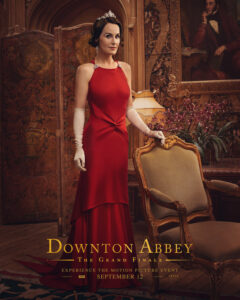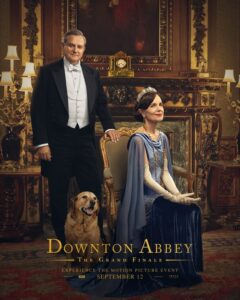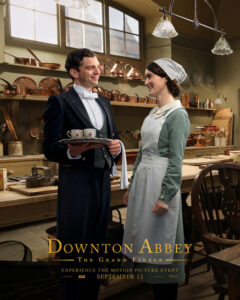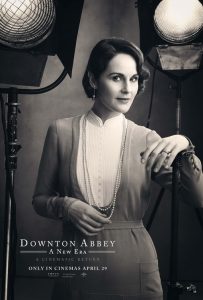Archive for the ‘Simon Curtis’ Category
An Elegant Transfer of Power
Downton Abbey: The Grand Finale

Director: Simon Curtis
Cast: Michelle Dockery, Joanne Froggatt, Hugh Bonneville, Elizabeth McGovern, Laura Carmichael, Joely Richardson, Alessandro Nivola, Dominic West, Phyllis Logan, Allen Leech, Robert James-Collier, Sophia McShera, Raquel Cassidy, Brendan Coyle, Penelope Wilton, Jim Carter, Lesley Nicol, Michael Fox, Harry Hadden-Paton, Douglas Reith, Simon Russell Beale, Arty Froushan
Running Time: 2 hours and 3 minutes
Film Rating: 8 out of 10
It’s the 1930 season in London and scandal erupts when at a royal gathering, Lady Petersfield played by Joely Richardson (Lady Chatterley’s Lover, Anonymous) discovers much to her shock and horror that Lady Mary Talbot of Downton Abbey, superbly played by Michelle Dockery, is divorced. Lady Mary resplendent in a ravishing red gown abruptly leaves the party with her reputation in ruin.

So begins the fractious premise of the final film Downton Abbey: The Grand Finale beautifully directed by Simon Curtis and featuring an all-star cast including newcomers Alessandro Nivola (American Hustle, Kraven the Hunter) as a scheming American Gus Sambrook and Persian American actor Arty Froushan as the witty playwright Noel Coward.

It is the age of Noel Coward and the Crawleys need to face some fresh challenges without the wit and sharp humour of the late Lady Gratham, a role written especially by screenwriter Julian Fellowes for the late Oscar winner Maggie Smith.
Besides Lady Mary’s divorce, there is the future of Lord and Lady Grantham, a sophisticated combination of British tradition and American wealth which is now on shaky ground. Paul Giamatti plays Lady Grantham’s brother Harold Levinson fresh off the boat from New York with startling news that the American wealth has somehow been depleted.
Lord Grantham played with vigour by Hugh Bonneville is facing the prospect of an early retirement, but screenwriter Julian Fellowes with skill and determination creates an elegant narrative tapestry expertly weaving several subplots into a brilliant storyline involving a character heavy story about a new decade in which old traditions are challenged and fresh ideas are hinting at an approaching modernity.

With beautiful costumes by Scottish designer Anna Mary Scott Robins particularly evident in the fabulous Ascot scene, Downton Abbey: The Grand Finale brings all the joy of the original series along with the cinematic grandeur of the big screen as the film follows the final chapter of The Crawleys as they navigate a changing world in which many of their customs vanish while the noble family learn to adapt, survive and embrace change.
Some notable scenes are between Laura Carmichael and Alessandro Nivola and of course between Oscar nominees Elizabeth McGovern (Ragtime) and Paul Giamatti (Cinderella Man, The Holdovers). It’s as if the supporting cast now has an opportunity to shine without the cynical gaze of Dame Maggie Smith looking at them with contempt. Although Maggie Smith’s absence in the film is felt keenly and Julian Fellowes acknowledges her ever lasting legacy.
Downton Abbey: The Grand Finale is an exquisite film centred on a masterful script filled with wit, humour and nuance written so beautifully by Oscar winner Julian Fellowes (Gosford Park) who has a knack of discovering the fine line between the landed gentry and the servants downstairs, whose lives are continually entwined.

If audiences enjoy etiquette, good wit and sophistication, then be sure not to miss Downton Abbey: The Grand Finale a lovely British film about the elegant transfer of power from one generation to the next in a rapidly changing world.
With a massive supporting cast, beautiful houses and gorgeous costumes, Downton Abbey: The Grand Finale gets a film rating of 8 out of 10 and is highly recommended viewing especially for those that loved the TV series.
An Evolving World
Downton Abbey: A New Era

Director: Simon Curtis
Cast: Maggie Smith, Hugh Dancy, Hugh Bonneville, Michelle Dockery, Dominic West, Tuppence Middleton, Elizabeth McGovern, Imelda Staunton, Penelope Wilton, Allen Leech, Nathalie Baye, Laura Haddock, Joanne Froggatt, Laura Carmichael, Sophie McShera, Robert James-Collier, Samantha Bond, Phyllis Logan, Jim Carter, Brendan Coyle, Michael Fox, Harry Hadden-Paton, Kevin Doyle, Charlie Watson, Jonathan Zaccai, Douglas Reith
Running Time: 2 hours and 5 minutes
Film Rating: 7.5 out of 10

Capitalizing on the success of the 2019 film Downton Abbey, a star studded sequel returns in its all glittering allure and this time Lady Violet Crawley wonderfully played with her usual coy dexterity by Oscar winner Maggie Smith (California Suite, The Prime of Miss Jean Brodie) reveals to her large and extended family at Downton that she has a villa in the South of France that was mysteriously left to her by a long last lover.
As Lady Crawley departs the gorgeously decorated drawing room she leaves with a final comment: “I will say good night and leave you all to discuss my mysterious past.”

Oscar winning screenwriter of the acclaimed Robert Altman 2001 film Gosford Park, Julian Fellowes once again returns to fine form with a familiar cast and adds a touch of glamour as half the cast set off for the French Riviera to meet the previous owners a French mother and son, wonderfully played by Nathalie Baye (Catch Me if You Can) and Jonathan Zaccai.

As Lady Mary, beautifully played once again with a crisp diction by Michelle Dockery, holds the fort at Downton Abbey as some fast and fashionable film people arrive to use the lavish estate as a location for what they would soon learn to be one of their last silent films.

The film crew is headed up by the dashing director Jack Barber wonderfully played by Hugh Dancy (Hysteria, Late Night) accompanied with flamboyance by the film’s stars Myrna Dagleish played by Laura Haddock and the male lead Guy Dexter superbly played with nuance by Dominic West (Chicago, Colette, Tomb Raider) as he reveals that he has hidden desires..

Fellowes cleverly gives all the cast members from the servants to the landed gentry equal screen time and an intriguing backstory, condensing the entire narrative into a poignant yet lavish affair which delicately reflects England and the Mediterranean at the end of the 1920’s, an evolving world which saw cinema become talkies, in which American novelist F. Scott Fitzgerald made the French Riviera fashionable in July.

From the beautiful costumes to the witty dialogue, from the elegant subplots to the age old rivalry between the British and the French, Downton Abbey: A New Era is a cinematic treat expertly crafted with an ensemble cast that achieve a formidable pitch with humour and grace.
Definitely made for the fans of the brilliant TV series and the 2019 film, Downton Abbey: A New Era is highly recommended viewing and a perfect cinematic outing, which gets a film rating of 7.5 out of 10.
A Dazzling Restitution
Woman in Gold
Director: Simon Curtis
Cast: Helen Mirren, Ryan Reynolds, Katie Holmes, Daniel Bruhl, Jonathan Pryce, Frances Fisher, Max Irons, Elizabeth McGovern, Charles Dance, Tatiana Maslany, Moritz Bleibtreu
My Week with Marilyn director Simon Curtis, follows up the success of that film with the brilliant Woman in Gold about art restitution based on a true account of how Maria Altmann an Austrian refugee fought to get Gustav Klimt’s famous and dazzling portrait of her aunt, Woman in Gold restored to her as the rightful owner after it was illegally seized by the Nazi’s in Vienna during the rise of the Third Reich in Europe.
Oscar winner Helen Mirren (The Queen) heads up an eclectic cast as Maria Altmann who approaches a young lawyer also of Austrian descent, Randy Schoenberg wonderfully played by Ryan Reynolds in one of his best screen performances to date to take on the Austrian government in reclaiming the gorgeous painting, which is in fact a family heirloom, now hanging in the Belvedere gallery in Vienna, Austria.
Woman in Gold is set in 1998 in Los Angeles with frequent flashbacks to the late 1930’s in Vienna which also charts the daring escape of young Maria, boldly played by Tatiana Maslany and her fiancé played by Max Irons (The Riot Club) from the Nazi’s who eventually flee to America, leaving her parents and all their wealth and possessions behind.
Director Simon Curtis deals with the thorny and sensitive issue of Art restitution in a nuanced and intelligent way which gives balance to both sides of this deeply complex case. Like George Clooney’s Monument’s Men which dealt also with the Nazi’s sacking Europe of its artistic treasures, Woman in Gold specifically focuses on this case and the exquisite painting Woman in Gold by the illustrious Austrian Cubist artist Gustav Klimt, which is like the Mona Lisa of Austria and a sign of national identity.
The fact that the value of the painting is worth well over R100 million dollars also adds impetus to Randy’s fight but more than that is the emotional toll it takes on both characters as they fight for justice amidst contemporary bigotry and the rightful ownership of a hugely recognizable painting.
Woman in Gold is ably assisted by a wonderful supporting cast including Daniel Bruhl (Rush), Katie Holmes (Pieces of April), Frances Fisher (The Lincoln Lawyer, Titanic), Charles Dance (White Mischief) and Jonathan Pryce (Carrington, Tomorrow Never Dies) but it is essentially held together by the superb performances of Mirren and Reynolds who despite their age difference make the film a fun, informative and deeply emotional quest to correctly addresses the wrongs of the past, in the name of art restitution and justice.
The fact that the international legal fight goes to the Supreme Court, which takes both Schoenberg and Altmann to Washington DC raises the level of the film along with the apparent assistance of the heir to the Estee Lauder fortune.
Woman in Gold is a fascinating, must see film for art lovers, and lovers of intelligent historical films which addresses a very topical and complex issue of restitution, which in this case dazzles with beauty. Highly recommended viewing.
Clashing of Vanities
My Week with Marilyn
My Week with Marilyn directed by Simon Curtis is a charming film about the clashing of vanities in a more subtle and polite society following the filming of the musical comedy The Late Prince which would become 1957 film The Prince and the Showgirl teaming up the great British Theatre personality Laurence Olivier and 1950’s American screen goddess Marilyn Monroe at Britain’s legendary Pinewood Studios.
Michelle Williams takes the part of Marilyn Monroe and might not be as voluptuous physically, but her brilliant performance of the doomed and fragile screen icon Monroe who was a legendary flirt and a consummate movie star is layered and superb. Kenneth Branagh is equally brilliant as the vain and pompous Laurence Olivier whose divergence into cinema with the Prince and the Showgirl was beset with problems on the Pinewood studios set especially made more difficult by the pill-popping, temperamental and sultry Monroe.
The clash between Monroe and Olivier went far deeper than vanity or fame, it was also a conflict of their two vastly different styles of acting. Monroe was trained in the Lee Strasberg school of method acting popular in Hollywood, California originally pioneered by Constantin Stanislavski and refers to the method of actors drawing on their own personal emotions and memories in their onscreen portrayals. Olivier was a London Shakespearian theatre actor and was quite unused to the medium of film.
Monroe felt and acted in the moment which worked brilliantly on the short takes of cinema, whilst Olivier was trained in the more established tradition of Classical Theatre where thespians rehearsed and performed a repertoire of theatre from Greek tragedy to plays by Sheridan, Shakespeare, Chekov and Noel Coward and prepared for their roles by learning their lines down to the last iambic pentameter and essentially being on time and in full costume. Their vastly different styles of acting is exemplified in the original 1957 film, The Prince and the Showgirl.
My week with Marilyn is told through the eyes of a 3rd Assistant Director Colin Clark played with surprising vigour by rising British Star Eddie Redmayne who is smitten by the tantalizing Marilyn Monroe and has a wonderful supporting cast including Zoe Wanamaker as Paula Strasberg, Dominic Cooper as Hollywood agent Milton Greene along with Julia Ormond as Laurence Olivier’s wife Vivien Leigh and Dougray Scott as playwright Arthur Miller, Marilyn’s husband at the time of shooting Prince and the Showgirl. Watch out for a great cameo by Dame Judi Dench playing the great Shakespearean actress Dame Sybil Thorndike. Where My Week with Marilyn excels is how beautifully it illustrates how divergent British and American cultures were especially in the 1950’s and how the clashing of vanities between the screen siren Monroe and the theatrical Olivier underlined both these stars own vulnerabilities and their strengthens.
Casting of Williams and Branagh as legendary stars Monroe and Olivier was critical in making My Week with Marilyn a lovely and substantial film about the making of film itself and the insecurities and drama that goes on between a Screen siren who knew how to titillate the public especially men and an aging theatre actor desperate to make his cinematic debut. Both Williams and Branagh deserved earned Oscar nominations for Best Actress and Best Supporting Actor but lost out to Meryl Streep for The Iron Lady and Christopher Plummer for Beginners at the 2012 84th Academy Awards.



